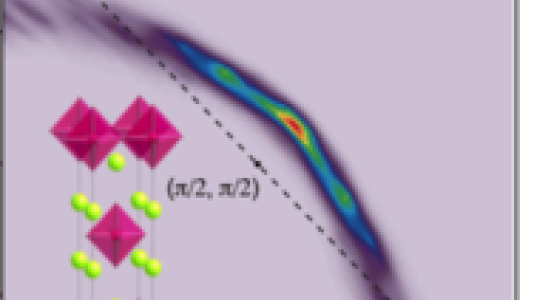
Although the mechanism of high temperature superconductivity (HTSC) remains an open question, it is commonly believed that certain unique features of cuprates are essential to high-temperature superconductivity: spin-1/2 moments on a quasi-two-dimensional square lattice, Heisenberg antiferromagnetic coupling, and no orbital degeneracy. The 5d transition-metal oxide Sr2IrO4 with a t2g5 valence shell is a Mott insulator in which the orbital degeneracy is removed through strong spin-orbit coupling, sharing the common spin dynamics of a Heisenberg antiferromagnet with nearest-neighbor magnetic exchange coupling. As a result, despite the very different starting electronic structures, the effective low-energy physics of Sr2IrO4 can be described by the same minimal model as developed for the cuprates, with comparable magnitudes of coupling constants, suggesting the possibility of unconventional HTSC upon carrier doping of this material.
We used K atoms to donate electrons in situ to the surface of cleaved single-crystal Sr2IrO4 and then measured the electronic structure using ARPES as a function of K coverage and temperature. Our results indicate that the parallel between Sr2IrO4 and cuprates persists in the metallic phase induced by electron doping, and that the ‘breaking up’ of a Fermi surface into disconnected segments is a general phenomenon of a system containing certain generic characteristics of cuprates. The formation of an arc, as opposed to ‘hot spots’ at intersections with magnetic zone boundary, indicates that the correlation strength in Sr2IrO4, which has been under intense debate, is in the intermediate-to-strong coupling regime. Thus, Mott physics and local correlations are essential for understanding of the physics of Sr2IrO4. We conclude that the phenomenology of the Fermi arc must be accountable within a minimal description of the physics of doping a single band, spin-1/2 antiferromagnetic Mott insulator, as shared by Sr2IrO4 and cuprates. Their differences in microscopic electronic structures help separate essential features of HTSC from material-specific features. Importantly, the nature of the charge gap as of Mott insulating (Sr2IrO4) or of charge transfer nature (cuprates) seems to have little bearing on the properties discovered in this work.
Related Article
“Fermi arcs in a doped pseudospin-1/2 Heisenberg antiferromagnet”
Y. K. Kim, O. Krupin, J. D. Denlinger, A. Bostwick, E. Rotenberg, Q. Zhao, J. F. Mitchell, J. W. Allen, B. J. Kim
Science 345, 187 (2014)